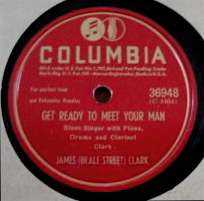Look on Yonder Wall
| "Get Ready to Meet Your Man" | |
|---|---|
 | |
| Single by James "Beale Street" Clark | |
| B-side | "Love Me or Let Me Be" |
| Released | 1945 |
| Format | 10-inch 78 rpm record |
| Recorded | October 24, 1945 |
| Genre | Blues |
| Label | Columbia (Cat. no. 36948) |
| Writer(s) | James Clark |
"Look on Yonder Wall", or "Get Ready to Meet Your Man" as it was first named, is a blues song first recorded in 1945 by James "Beale Street" Clark. Clark, also known as "Memphis Jimmy", was a blues pianist from Memphis, Tennessee. During the 1940s, he appeared on recordings by Jazz Gillum, Red Nelson (aka Dirty Red), and an early Muddy Waters session, as well as several singles in his own name.
Origins
"Look on Yonder Wall" was performed as a mid-tempo twelve-bar blues, with a recurrent post-World War II theme.[1] It tells of a "man who is somewhat disabled and has not been drafted and takes advantage of that to entertain lonely married women".[1]
Now baby I've been worried, ever since victory day
Every time I pick up the paper, your man is comin' this a way
Look on yonder wall, hand me down my walkin' cane
Said I'm gonna find me woman, woo-hoo look here come your man
Now your man have been in the army, 'n' I know that awful rough
I don't know how many men he done killed, but I think he done killed enough
Jazz Gillum, with whom the song is often associated, recorded a version on February 18, 1946, (RCA Victor 20-1974), four months after Clark. Although the release was retitled, it credits "James Clark" as the composer.[2]
Elmore James version
In 1961, Elmore James recorded his version of "Look on Yonder Wall" as the flip side of "Shake Your Moneymaker" (Fire 504). Backing James (vocal and guitar) are Sammy Myers (harmonica), Johnny "Big Moose" Walker (piano), Sammy Lee Bully (bass), and King Mose (drums). The song is one of the few Elmore James songs to feature harmonica,[3] as he typically used saxophone.
Recordings by other artists
"Look on Yonder Wall" has been interpreted and recorded by many different performers. Although several titles are used, some of the earlier releases are credited to "James Clark". After James recorded his version, most artists who covered the song used his arrangement.
- 1950 – Arthur "Big Boy" Crudup as "Hand Me Down My Walking Cane" (RCA 22-0100).
- 1952 – Boyd Gilmore as "Just an Army Boy" (Modern 860).[4]
- 1962 – Junior Parker as "Yonder's Wall" (Duke 367).
- 1964 – Homesick James as "Crutch and Cane" from Blues Southside Chicago.
- 1964 – Eddie Boyd as "Look on Yonder Wall" from Southside Chicago.
- 1965 – Junior Wells with Buddy Guy as "Yonder Wall" from Hoodoo Man Blues.
- 1965 – Paul Butterfield as "Look Over Yonders Wall" from The Paul Butterfield Blues Band.
- 1969 – Earl Hooker as "Look Over Yonder's Wall" from Don't Have to Worry.
- 1970 – Freddie King as "Yonder Wall" from My Feeling for the Blues.
- 1984 – J. B. Hutto as "Look at the Yonder Wall" from Slideslinger (bonus tracks).
- 1999 – Gov't Mule as "Look on Yonder Wall" from Live... With a Little Help from Our Friends.
- 2010 – Joe Bonamassa as "Look Over Yonder's Wall" from Black Rock.
- 2010 – Steve Miller as "Look on Yonder Wall" from Bingo! (bonus tracks).
References
- 1 2 Herzhaft, Gerard (1992). "Look Over Yonder's Wall". Encyclopedia of the Blues. University of Arkansas Press. p. 459. ISBN 1-55728-252-8.
- ↑ van Rijn, Guido (2006). The Truman and Eisenhower Blues. Continuum. p. 157. ISBN 978-0-8264-9068-1.
- ↑ "Dust My Broom", Elmore James' first single, featured harmonica by Sonny Boy Williamson II (1951 Trumpet 146).
- ↑ "Illustrated Boyd Gilmore discography". Wirz.de. Retrieved 2016-11-15.